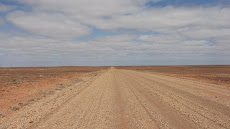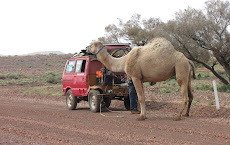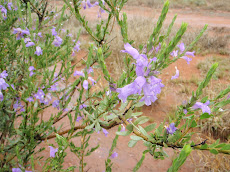How good it is to be back in Alice Springs with always more to do and see. We have well-supported the Alice economy on each of our visits, especially fix-it outlets: this latest with the purchase of an expensive electrical invertor to replace the one that died, of irresistible books at Red Kangaroo bookshop and of course the dreaded Coles supermarket and liquor outlet. Another lunch at the Olive Pink Botanic Gardens cafe noting the Bower Birds extra nest decoration (plastic clothes pegs), a visit to the arts centre at Araluen to watch a moving video about Geoff Bardon and the birth of the Papunya Tula art movement, a drive south to the Rain Dreaming rock carvings at Ewaninga (right).
 A couple of days in the MacDonnell Ranges Big 4 caravan park was quite enough after shelling out $43 per night – admittedly the loo paper was superior, and irons were laid on should sartorial splendour be required; we wore freshly ironed shirts for the election night party! So when we discovered the “bird ladies” were booked in over the road at G’day Mate we inveigled our way in to this delightful small park for $30. Little did it know it was to host a splendid party in our slot behind the shed to welcome Jane and violinist Hollis, who chases Pied Butcher birds all over the inland to record their polyphonic calls for her post-doctoral work. As luck would have it, our friend Andrew Crouch’s ornithologist father had recorded birds (including the Butcher bird) and his work was known to the bird ladies, so Andrew dropped in to meet them and swap stories and CDs. Despite a disgraceful array of empty bottles, Hollis as usual arose at 3am to record this musical bird.
A couple of days in the MacDonnell Ranges Big 4 caravan park was quite enough after shelling out $43 per night – admittedly the loo paper was superior, and irons were laid on should sartorial splendour be required; we wore freshly ironed shirts for the election night party! So when we discovered the “bird ladies” were booked in over the road at G’day Mate we inveigled our way in to this delightful small park for $30. Little did it know it was to host a splendid party in our slot behind the shed to welcome Jane and violinist Hollis, who chases Pied Butcher birds all over the inland to record their polyphonic calls for her post-doctoral work. As luck would have it, our friend Andrew Crouch’s ornithologist father had recorded birds (including the Butcher bird) and his work was known to the bird ladies, so Andrew dropped in to meet them and swap stories and CDs. Despite a disgraceful array of empty bottles, Hollis as usual arose at 3am to record this musical bird. After the past couple of days of rain and on the strength of a report of vans stranded on the Oodnadatta Track, we decided to stay another night in Alice and accompany Jane and Hollis out to the Owen Springs Reserve, NT’s first pastoral station, with homestead ruins dating to the 1880’s, and bought by the NT government in 2003. After watching them record fence music we left them after lunch in a drizzle, to camp along the Hugh River to continue their quest for birdsong. Ian and I continued the 50 km loop through mud and sandy river beds with a view of Redbank Waterhole and its lovely empty campsites, back to the Stuart Hwy into Alice in time to get to the video shop. We feel brave enough to watch Wolf Creek for the first time, having survived a visit to the crater on our way up the Tanami a few weeks ago. (PS the movie was horrific and we had to have pizza to recover).
So tomorrow it seems we finally leave and head down the Stuart Highway bitumen for 400km or so to Marla, and maybe miracles will happen to dry the Oodnadatta Track enough to re-open. Awaking this morning to a text message from our mate Terri with pictures of my bulbs flowering is spurring the homeward journey.



































































































